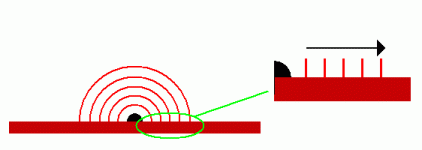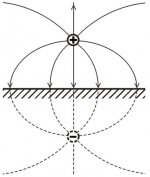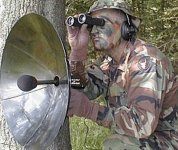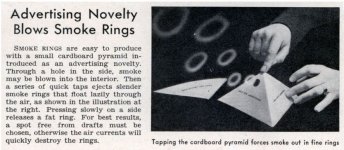If you look at post 11 its gets more confusing. And system7 how does the felt reduce the output from the tweeter?
I have to admit I'm a bit woolly on that! I'm usually more interested in deeper problems in physics....
But a Conformal Mapping -- from Wolfram MathWorld and the Method of Images would be my approach to analysis.
An externally hosted image should be here but it was not working when we last tested it.
https://semiaccurate.com/forums/showthread.php?t=4667&page=4
You see, where you have a boundary, you get an image of the acoustic source. If the boundary is damped by felt at certain frequencies, the image is weaker so reinforces less. This is why putting a speaker against a hard wall boosts bass 6dB.
Attachments
Do they have cutouts for the drivers?I passed a shop that sells sheepskin seat covers for cars.
Well, the grazing rays from the drivers are the ones to control, exactly because they "see" the baffle edges and are diffracted. Even if the baffle edges are rounded and chamfered to control diffraction, the grazing rays also "see" the frame of a typical grille. Reducing the strength of the grazing rays is a step towards controlling the deleterious effects of edge and grille diffraction. A typical dome tweeter with plate set flush in a baffle, still has a dome proud of the baffle surface and will generate low angle incidence waves on the baffle.Bon,
if we have a tweeter mounted flush in a baffle. What would be the incident angle of the sound traveling from the tweeter along the baffle surface? The thread opener did not ask about edge diffraction of any sort.

This is a picture of a dome tweeter on a brown baffle. The red half-circles are the fronts of the sound waves which consecutively radiate from the dome:


In the picture I have singled out the situation, where the wavefronts are "sliding along the baffle". What is "nasty" about it? Why should they not really be there?Its also intuitively clear that it must be soaking up some of those nasty waves which are sliding along the baffle that should not really be there.
What do you guys think?
If there are no reflections whats the point of applying wool? Why does it work?
This is a picture of a dome tweeter on a brown baffle. The red half-circles are the fronts of the sound waves which consecutively radiate from the dome:
View attachment 315178
In the picture I have singled out the situation, where the wavefronts are "sliding along the baffle". What is "nasty" about it? Why should they not really be there?
The reason you are getting confused is because you are oversimplifying. How can you be sure that the grazing angle of the tweeter rays are exactly 0 radians? Only in theory do such extreme cases arise. In practice, you are looking at strictly positive grazing angles, which means reflections do occur. In addition
the texture of the baffle, the geometry of the tweeter faceplate, can all affect the outcome.
How can you be sure that the grazing angle of the tweeter rays are exactly 0 radians? Only in theory do such extreme cases arise. In practice, you are looking at strictly positive grazing angles, which means reflections do occur.
You deny grazing angles of 0 radians, but you believe in misterious reflections which do not exist. I'm baffled.
They get real "nasty" when they inevitably reach the baffle or grille edge. Then diffraction gives you a delayed, phase shifted version added to the original signal.In the picture I have singled out the situation, where the wavefronts are "sliding along the baffle". What is "nasty" about it? Why should they not really be there?
I'm very well aware of what's happening at the baffle edge.They get real "nasty" when they inevitably reach the baffle or grille edge. Then diffraction gives you a delayed, phase shifted version added to the original signal.
But that's not the question the OP and I asked. Do you have any opinion if there is a problem for the waves just travelling on the plain baffle surface?

I wouldn't call it oversimplifying. I'm just trying to keep one effect separated from the other. That indeed makes it easier for me to understand.The reason you are getting confused is because you are oversimplifying.
The grazing angle need not be 0° exactly, that's right. But I don`t see how it could be any greater than 10°. Since the exit angle equals the incidence angle, the reflected wave would not travel much different from the original wave imho.How can you be sure that the grazing angle of the tweeter rays are exactly 0 radians? Only in theory do such extreme cases arise. In practice, you are looking at strictly positive grazing angles, which means reflections do occur.
Sorry, I am a slow thinker.In addition the texture of the baffle, the geometry of the tweeter faceplate, can all affect the outcome.
I have pointed out a number of reviewed research articles which discuss the issue grazing ray contribution to far field sound radiation. The most recent is the Masters thesis of Vladimir Pavasovic. He describes the scope of his study thus:Do you have any opinion if there is a problem for the waves just travelling on the plain baffle surface?

This research has attempted to answer the following questions:
- What is the best method for effectively modeling sound radiation at grazing angles relative to that in the normal direction?
- What are the contributing factors to the amount of sound propagated to the far-field?
- What is the sound radiation when the angle of incidence is close to 90º?
The treatment is mathematical and the predictions are in accord with previous numerical simulations and experimental measurements of other researchers. The study is motivated by attempting to understand the sound radiation from panels and orifices in factory roofs, which IMO has a reasonable basis for comparison with the sound field radiated by a loudspeaker diaphram.
I want to see if I can get an agreement from the experts here about this. I was having a dispute with a professor of physics about the use of wool to control reflections from the tweeter. He tells me there is no reflection since there is no wave with angle of incidence at pi/2 radians.
I can clearly hear the positive effects of wool on the baffle. Its also intuitively clear that it must be soaking up some of those nasty waves which are sliding along the baffle that should not really be there.
What do you guys think?
If there are no reflections whats the point of applying wool? Why does it work?
I had to think about your professors comments a bit. At first I thought he was saying that there is no energy radiated at 90 degrees, clearly not the case.
Rather he seems to be saying that no energy is coming at an angle and bouncing off the baffle to the sides of the tweeter (i.e. energy doesn't go out into space and curve back to bounce off the baffle at some distance from the tweeter, this assuming your thermal gradients aren't too great!**).
This may be true but we see that there is a significant difference between the damped baffle case and the undamped baffle. The undamped case is clearly suffering from diffraction that the stuffing reduces.
My assumption has always been that the baffle damping either hides the edges (and does so without creating a reflective barrier), or that the energy moving down the damped surface constantly turns into the absorbing material. Either way, the impedance transition at the edge is reduced (or at least the energy getting to it), and secondary radiation is no longer a problem.
Your professor's error is in thinking that the only use for damping would be in killing energy arriving at a non grazing incidence. Clearly it works on the grazing incidence energy as well.
**http://www.acs.psu.edu/drussell/Demos/refract/refract.html
David S.
Last edited:
I don't think we have got a handle on this problem yet. I've slept on it, and I'm still not there. We've got to ask the right question. 
Let's state the question clearly. What will be the effect of adding some damping felt around the front baffle, and particularly the tweeter?
Now the air on the baffle front is not moving, it is constrained by the boundary. What IS moving is a pressure wave away from the tweeter dome. It eventually meets the speaker edge and diffracts in all directions.
I don't know if thinking about putting felt on a parabolic microphone dish is the same problem, but I could certainly map it conformally into a loudspeaker.
I just include the smoke rings, because a tweeter might be doing something similar and we should keep open minds.
Let's state the question clearly. What will be the effect of adding some damping felt around the front baffle, and particularly the tweeter?
An externally hosted image should be here but it was not working when we last tested it.
Now the air on the baffle front is not moving, it is constrained by the boundary. What IS moving is a pressure wave away from the tweeter dome. It eventually meets the speaker edge and diffracts in all directions.
I don't know if thinking about putting felt on a parabolic microphone dish is the same problem, but I could certainly map it conformally into a loudspeaker.
I just include the smoke rings, because a tweeter might be doing something similar and we should keep open minds.
Attachments
Yes, that and felt and faux fur. It all works. I use artificial sheepskin in front of my bullet tweeters that are not mounted on a baffle. It really help FR and phase. Wool felt on a baffle face will give an audibly smoother result.Anybody tried gluing a sheepskin to the front baffle with cutouts for the drivers?
I don't understand why the big argument. Just try it - it's easy to hear and measure the effect.
The grazing angle need not be 0° exactly, that's right. But I don`t see how it could be any greater than 10°.
Sorry, I am a slow thinker.You are too fast for me. Can't we take one step at a time?
So you believe that there are mysterious soundwaves from the tweeter whose angle of incidence is 0~10 degrees. Can you explain where such waves would come from? You initially told me yourself that no such waves can exist.
Since the exit angle equals the incidence angle, the reflected wave would not travel much different from the original wave imho.
That reflection will be delayed so it will smear the time domain performance.
I did talk of a grazing angle of 0-10°. If I got the definitions right the grazing angle is 90°- incidence angle. Does that help?So you believe that there are mysterious soundwaves from the tweeter whose angle of incidence is 0~10 degrees. Can you explain where such waves would come from? You initially told me yourself that no such waves can exist.
Yes. For a flush mounted 1" tweeter it may become a problem in the ultrasonic region perhaps.That reflection will be delayed so it will smear the time domain performance.
Seems to me that if there were any of these waves able to just barely reflect off the baffle, as opposed to nicely propagating out until diffracting into full space at the edge, they would be extremely low amplitude and nearly 90° off-axis. Pretty insignificant compared to edge diffraction, which is already usually a minor effect.
Seems to me that if there were any of these waves able to just barely reflect off the baffle, as opposed to nicely propagating out until diffracting into full space at the edge, they would be extremely low amplitude and nearly 90° off-axis. Pretty insignificant compared to edge diffraction, which is already usually a minor effect.
Yeah, but some guys like to argue about minutiae.
I think everyone is floundering with this one...
All very "Woolly" and "Baffling" for sure.
There doubtless IS an effect. But none of you geniuses has come near predicting exactly WHAT happens or WHY.
Me, I'm clueless. But the muse may come to me yet...
I always think if you can't explain something simply, you don't understand it.
All very "Woolly" and "Baffling" for sure.
There doubtless IS an effect. But none of you geniuses has come near predicting exactly WHAT happens or WHY.
Me, I'm clueless. But the muse may come to me yet...
I always think if you can't explain something simply, you don't understand it.
- Status
- This old topic is closed. If you want to reopen this topic, contact a moderator using the "Report Post" button.
- Home
- Loudspeakers
- Multi-Way
- wool on the baffle?


